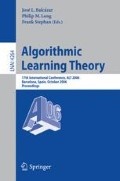Abstract
In this paper, we review some known results that relate the statistical query complexity of a concept class to the spectral norm of its correlation matrix. Since spectral norms are widely used in various other areas, we are then able to put statistical query complexity in a broader context. We briefly describe some non-trivial connections to (seemingly) different topics in learning theory, complexity theory, and cryptography. A connection to the so-called Hidden Number Problem, which plays an important role for proving bit-security of cryptographic functions, will be discussed in somewhat more detail.
This work was supported in part by the IST Programme of the European Community, under the PASCAL Network of Excellence, IST-2002-506778. This publication only reflects the authors’ views.
Access this chapter
Tax calculation will be finalised at checkout
Purchases are for personal use only
Preview
Unable to display preview. Download preview PDF.
References
Ben-David, S., Itai, A., Kushilevitz, E.: Learning by distances. Information and Computation 117(2), 240–250 (1995)
Blum, A., Furst, M., Jackson, J., Kearns, M., Mansour, Y., Rudich, S.: Weakly learning DNF and characterizing statistical query learning using Fourier analysis. In: Proceedings of the 26th Annual Symposium on Theory of Computing, pp. 253–263 (1994)
Blum, A., Kalai, A., Wasserman, H.: Noise-tolerant learning, the parity problem, and the statistical query model. Journal of the Association on Computing Machinery 50(4), 506–519 (2003)
Boneh, D., Venkatesan, R.: Hardness of Computing the Most Significant Bits of Secret Keys in Diffie-Hellman and Related Schemes. In: Koblitz, N. (ed.) CRYPTO 1996. LNCS, vol. 1109, pp. 129–142. Springer, Heidelberg (1996)
Forster, J.: A linear lower bound on the unbounded error communication complexity. Journal of Computer and System Sciences 65(4), 612–625 (2002)
Forster, J., Krause, M., Lokam, S.V., Mubarakzjanov, R., Schmitt, N., Simon, H.U.: Relations between communication complexity, linear arrangements, and computational complexity. In: Hariharan, R., Mukund, M., Vinay, V. (eds.) FSTTCS 2001. LNCS, vol. 2245, p. 171. Springer, Heidelberg (2001)
Kearns, M.: Efficient noise-tolerant learning from statistical queries. Journal of the Association on Computing Machinery 45(6), 983–1006 (1998)
Kiltz, E.: A useful primitive to prove security of every bit and about hard core predicates and universal hash functions. In: Proceedings of the 14th International Symposium on Fundamentals of Computation Theory, pp. 388–392 (2001)
Kiltz, E., Simon, H.U.: Unpublished Manuscript about the Hidden Number Problem
Kiltz, E., Simon, H.U.: Threshold circuit lower bounds on cryptographic functions. Journal of Computer and System Sciences 71(2), 185–212 (2005)
Krause, M., Waack, S.: Variation ranks of communication matrices and lower bounds for depth two circuits having symmetric gates with unbounded fan-in. Mathematical System Theory 28(6), 553–564 (1995)
Nguyên, P.Q., Stern, J.: The two faces of lattices in cryptology. In: Silverman, J.H. (ed.) CaLC 2001. LNCS, vol. 2146, p. 146. Springer, Heidelberg (2001)
Paturi, R., Simon, J.: Probabilistic communication complexity. Journal of Computer and System Sciences 33(1), 106–123 (1986)
Valiant, L.G.: A theory of the learnable. Communications of the ACM 27(11), 1134–1142 (1984)
Vasco, M.I.G., Shparlinski, I.E.: On the security of Diffie–Hellman bits. In: Proceedings of the Workshop on Cryptography and Computational Number Theory, pp. 331–342 (2000)
Yang, K.: On learning correlated boolean functions using statistical queries (Extended abstract). In: Abe, N., Khardon, R., Zeugmann, T. (eds.) ALT 2001. LNCS, vol. 2225, p. 59. Springer, Heidelberg (2001)
Yang, K.: New lower bounds for statistical query learning. In: Kivinen, J., Sloan, R.H. (eds.) COLT 2002. LNCS, vol. 2375, p. 229. Springer, Heidelberg (2002)
Yang, K., Blum, A.: On statistical query sampling and nmr quantum computing. In: Proceedings of the 18th Annual Conference on Computational Complexity, pp. 194–208 (2003)
Author information
Authors and Affiliations
Editor information
Editors and Affiliations
Rights and permissions
Copyright information
© 2006 Springer-Verlag Berlin Heidelberg
About this paper
Cite this paper
Simon, H.U. (2006). Spectral Norm in Learning Theory: Some Selected Topics. In: Balcázar, J.L., Long, P.M., Stephan, F. (eds) Algorithmic Learning Theory. ALT 2006. Lecture Notes in Computer Science(), vol 4264. Springer, Berlin, Heidelberg. https://doi.org/10.1007/11894841_4
Download citation
DOI: https://doi.org/10.1007/11894841_4
Publisher Name: Springer, Berlin, Heidelberg
Print ISBN: 978-3-540-46649-9
Online ISBN: 978-3-540-46650-5
eBook Packages: Computer ScienceComputer Science (R0)

